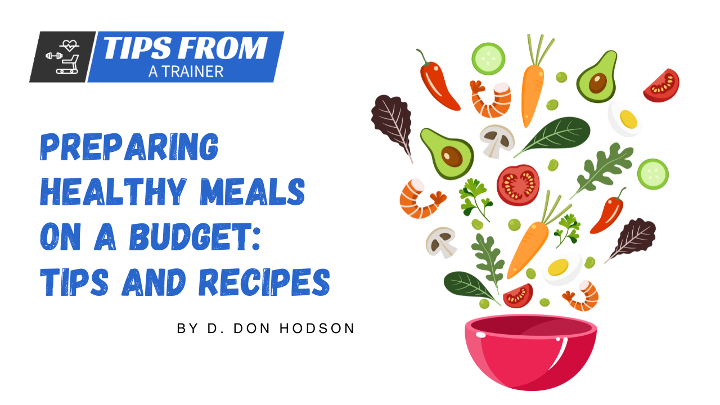Introduction
Eating healthy on a budget is not only possible but also essential for overall well-being. When you prioritize nutritious meals while being mindful of your finances, you can nourish your body and support your health without breaking the bank.
In this article, we will explore various tips, strategies, and recipes to help you prepare healthy meals on a budget.
Table of Contents
Introduction
Understanding the Basics of Budget-Friendly Healthy Eating
Overview of budget-friendly healthy eating principles
Importance of balance and variety in meals
Key nutrients to focus on and their sources
Strategies for maximizing nutrition while minimizing costs
Meal Planning for Cost-Effective Healthy Eating
Benefits of meal planning
Steps to create a budget-friendly meal plan
Batch cooking and meal prep
Smart Shopping Strategies for Budget-Friendly Meals
- Compare prices and brands
- Shop seasonal and local produce
Cooking Techniques for Budget-Friendly Meals
Embrace cooking from scratch
Optimize Ingredient Usage
Plan meals with overlapping ingredients
Make use of affordable pantry staples
Meal Prepping for Cost-Effective Eating
Plan your meals in advance
Batch cook and portion meals
Freeze meals for future use
Utilize versatile ingredients
Make the Most of Staple Ingredients
Rice and grains
Eggs
Canned and Frozen Produce
Conclusion

Understanding the Basics of Budget-Friendly Healthy Eating
Overview of budget-friendly healthy eating principles
Budget-friendly healthy eating is about making smart choices that optimize nutrition without compromising your wallet. It involves finding a balance between affordability and nutrient density. Rather than focusing on expensive superfoods or trendy ingredients, it's important to emphasize whole, minimally processed foods that offer a range of essential nutrients.
Importance of balance and variety in meals
Achieving a balanced and varied diet is key to meeting your nutritional needs while keeping costs in check. Incorporating a mix of fruits, vegetables, whole grains, lean proteins, and healthy fats ensures that you're getting a wide range of vitamins, minerals, fiber, and other beneficial compounds. Aim for a colorful plate that includes different food groups to maximize nutrition and flavor.
Key nutrients to focus on and their sources
While it's important to obtain a variety of nutrients, there are a few key ones to prioritize when eating on a budget. These include:
Protein
Opt for affordable protein sources such as chicken, eggs, legumes, and tofu. These options provide high-quality protein without straining your budget.
Fiber
Whole grains, beans, lentils, fruits, and vegetables are excellent sources of fiber. They not only promote digestive health but also help you feel full and satisfied for longer periods.
Healthy fats
Incorporate budget-friendly fats like olive oil, avocados, and nuts. These provide essential fatty acids and help increase satiety.
Vitamins and minerals
Fresh fruits and vegetables, especially seasonal and locally grown varieties, are rich in vitamins and minerals. They offer a cost-effective way to obtain essential nutrients.
Strategies for maximizing nutrition while minimizing costs
To get the most nutrition out of your budget, consider the following strategies:
Shop smart
Plan your meals in advance and create a shopping list based on your meal plan. Stick to the list to avoid impulse buying and unnecessary expenses.
Buy in bulk
Purchase staple items like rice, pasta, beans, and oats in bulk. This often results in significant savings over time.
Utilize frozen and canned produce
Frozen and canned fruits and vegetables are a convenient and cost-effective option, especially when fresh produce is expensive or out of season. They retain their nutritional value and can be used in various recipes.
Cook from scratch
Pre-packaged and processed foods tend to be more expensive. By cooking meals from scratch, you have better control over the ingredients, portions, and cost.
Meal prep and leftovers
Plan and prepare meals in batches to minimize waste and have ready-to-eat options throughout the week. Leftovers can be repurposed into new dishes or enjoyed as is.
Meal Planning for Cost-Effective Healthy Eating
Benefits of meal planning
Meal planning is an effective tool for saving money, reducing food waste, and promoting healthier eating habits. By taking the time to plan your meals in advance, you can avoid last-minute takeout orders and impulsive grocery purchases. Meal planning also allows you to incorporate a variety of nutritious foods, balance your meals, and ensure you're staying within your budget.
Steps to create a budget-friendly meal plan
Creating a budget-friendly meal plan involves a few simple steps:
Assess your pantry and fridge
Take inventory of the ingredients you already have. This helps you avoid unnecessary purchases and makes it easier to plan meals around existing items.
Set a budget
Determine how much you can allocate for groceries each week or month. This gives you a clear spending limit and helps you make informed choices while shopping.
Research sales and discounts
Check for sales, discounts, and coupons before making your shopping list. This way, you can take advantage of special offers and maximize your savings.
Plan your meals
Consider your dietary preferences, nutritional needs, and available ingredients. Create a meal plan for the week, including breakfast, lunch, dinner, and snacks. Aim for a balance of flavors, textures, and nutrients in each meal.
Make a shopping list
Based on your meal plan, create a comprehensive shopping list that includes all the necessary ingredients. Stick to the list while shopping to avoid unnecessary purchases.
Batch cooking and meal prep
Batch cooking and meal prep are excellent strategies for saving time and money while ensuring you have healthy meals readily available. Here's how you can incorporate batch cooking and meal prep into your routine:
Choose a designated day
Set aside a specific day or time each week for batch cooking. This allows you to focus on preparing multiple meals at once.
Cook in bulk
Prepare larger portions of staple items like grains, proteins, and vegetables. This can be as simple as cooking a big pot of brown rice, grilling several chicken breasts, or roasting a tray of mixed vegetables.
Store and portion meals
Once cooked, divide the meals into individual or family-sized portions. Store them in airtight containers in the refrigerator or freezer for later use.
Plan for versatility
When batch cooking, consider the versatility of the prepared ingredients. Cooked proteins, grains, and vegetables can be used in various dishes throughout the week, allowing for a range of flavors and textures.
Utilize meal prep containers
Invest in a set of reusable meal prep containers to store and transport your prepared meals. These containers are convenient, space-saving, and help maintain portion control.
By implementing meal planning, batch cooking, and meal prep, you can streamline your healthy eating routine, save time, and make the most of your budget.
Smart Shopping Strategies for Budget-Friendly Meals
Compare prices and brands
When shopping on a budget, it's important to compare prices and brands to get the best value for your money. Consider visiting different stores or checking online platforms to compare prices for the items on your shopping list. Additionally, don't be afraid to try different brands or store brands, as they often offer comparable quality at a lower cost.
Shop seasonal and local produce
Seasonal and local produce tends to be more affordable and fresher compared to out-of-season or imported options. Visit farmers markets or join community-supported agriculture (CSA) programs to access a wide variety of locally grown fruits and vegetables. Not only will you support local farmers, but you'll also enjoy the benefits of fresh, nutritious produce at a lower cost.
Purchase in bulk or family-sized packs
Buying in bulk or opting for family-sized packs can help reduce the cost per serving. Look for pantry staples like grains, legumes, nuts, and seeds that can be stored for a long time without losing quality. By purchasing these items in larger quantities, you can save money in the long run and have a readily available supply of essential ingredients.
Don't overlook frozen and canned options
Frozen and canned fruits, vegetables, and proteins are often more affordable and have a longer shelf life compared to fresh counterparts. They can be just as nutritious and offer convenience when fresh produce is not available or affordable. Look for options without added sugars, sodium, or preservatives. Frozen fruits can be added to smoothies, and canned beans can be used in soups, stews, or salads.
Shop from the bulk bins
Bulk bins are a great way to purchase specific quantities of ingredients, especially spices, grains, nuts, and dried fruits. By buying only what you need, you can save money and reduce food waste. Be sure to bring your own reusable bags or containers to avoid additional packaging.
Cooking Techniques for Budget-Friendly Meals
Embrace cooking from scratch
Cooking from scratch is not only more affordable but also allows you to have more control over the ingredients and flavors in your meals. Instead of relying on pre-packaged or processed foods, experiment with homemade versions of sauces, dressings, and condiments. By using basic ingredients like herbs, spices, oils, and vinegar, you can create flavorful and budget-friendly options.
Optimize ingredient usage
To make the most of your ingredients, consider using every part of the produce or protein. For example, save vegetable scraps to make homemade vegetable broth or use leftover chicken bones to make a nourishing bone broth. Additionally, repurpose leftovers by transforming them into new dishes or incorporating them into salads or wraps.
Plan meals with overlapping ingredients
When meal planning, look for opportunities to use overlapping ingredients across multiple dishes. For instance, if you're planning to cook roasted vegetables, consider incorporating them into salads, grain bowls, or wraps throughout the week. This not only reduces waste but also saves you money by utilizing ingredients efficiently.
Make use of affordable pantry staples
Pantry staples like rice, pasta, beans, lentils, and canned tomatoes are budget-friendly and versatile ingredients. They can be the foundation of many nutritious and cost-effective meals. Get creative with these staples by trying different recipes and flavor combinations to keep your meals exciting and satisfying.
Meal Prepping for Cost-Effective Eating
Plan your meals in advance
Meal prepping is a great strategy to save time and money while ensuring you have nutritious meals throughout the week. Take some time each week to plan your meals, including breakfast, lunch, dinner, and snacks. Consider using ingredients that are on sale or in season to maximize your budget.
Batch cook and portion meals
Once you have your meal plan, dedicate a specific time to batch cook your meals for the week. Cook larger quantities of grains, proteins, and vegetables, and divide them into individual portions or meal-sized containers. This way, you can easily grab a pre-portioned meal when you're in a hurry, avoiding the temptation of ordering takeout.
Freeze meals for future use
If you're concerned about food waste or if you have leftovers from your meal prep, freezing is an excellent option. Portion out your meals into freezer-safe containers or bags and label them with the date. Frozen meals can be quickly reheated for a convenient and budget-friendly option on busy days.
Utilize versatile ingredients
When meal prepping, focus on versatile ingredients that can be used in multiple dishes throughout the week. For example, roast a whole chicken and use the meat for sandwiches, salads, and stir-fries. Cook a big pot of beans and incorporate them into soups, stews, and grain bowls. By maximizing the usage of versatile ingredients, you can create a variety of meals without excessive spending.
Make the Most of Staple Ingredients
Rice and Grains
Rice and grains are affordable and versatile staples that can be incorporated into a variety of meals. Opt for brown rice, quinoa, or whole wheat pasta for added nutritional value. Cook a big batch of grains at the beginning of the week and use them as a base for different dishes. Add cooked grains to salads, stir-fries, or soups for a filling and budget-friendly meal.
Eggs
Eggs are a cost-effective source of protein and can be used in numerous ways. Whip up a vegetable-packed omelet for breakfast or dinner, make a frittata with leftover vegetables, or hard-boil eggs for a quick and nutritious snack. Eggs can also be used as a binding agent in recipes like meatballs or veggie burgers, reducing the need for additional ingredients.
Canned and Frozen Produce
Canned and frozen produce are excellent options when fresh produce is not readily available or affordable. Canned vegetables, such as diced tomatoes or beans, can be added to soups, stews, and casseroles for added nutrients and flavor. Frozen fruits and vegetables can be used in smoothies, stir-fries, or baked goods. Look for sales or buy in bulk to save even more money.
Conclusion
Preparing healthy meals on a budget is not only possible but also enjoyable with the right strategies and recipes. By focusing on cost-effective ingredients, planning ahead, and utilizing versatile cooking techniques, you can nourish yourself and your family without breaking the bank. Remember to prioritize whole foods, incorporate a variety of vegetables and lean proteins, and make use of pantry staples to create delicious and budget-friendly meals. With a little creativity and resourcefulness, you can eat well, save money, and take control of your nutritional health.
Stay tuned for more budget-friendly meal ideas and tips in our upcoming articles.

Don Hodson, Certified Personal Trainer
I'm Don, an ACE-certified personal trainer and the founder of Tips From A Trainer. With my passion for fitness and years of experience, I've helped countless individuals transform their physiques!
Having personally overcome weight challenges throughout my life, I understand the struggle. Through consistency, exercise, and a balanced diet, I have managed to stay in shape and I want to share my message with the world!
The fitness industry is fraught with misconceptions and deceptive practices, which is why I am committed to providing you with the truth.
- My Site: www.Don-Hodson.com
- My Company: www.ConnectedAgeMarketing.com

Preparing Healthy Meals on a Budget